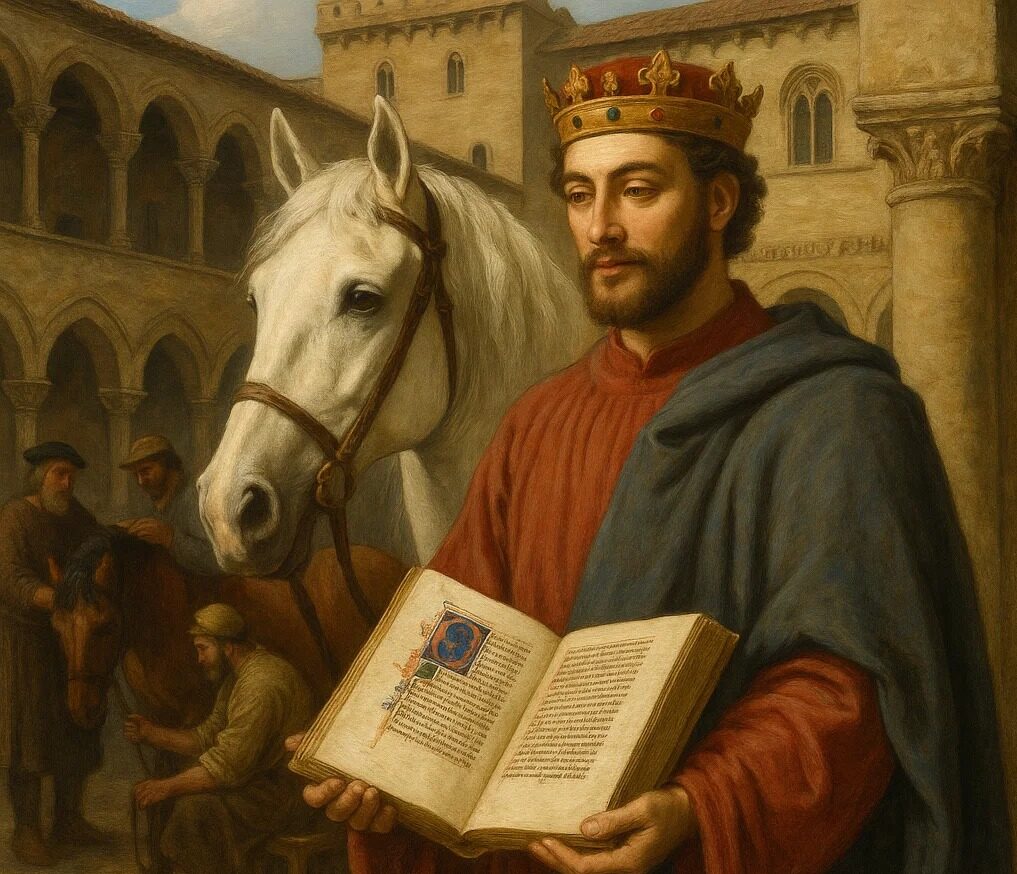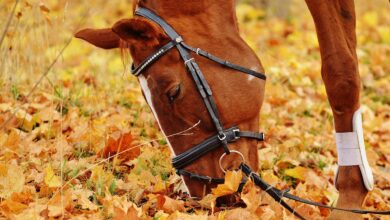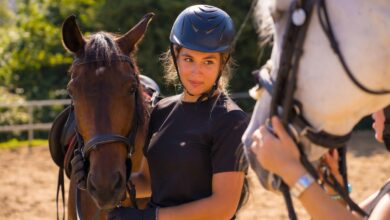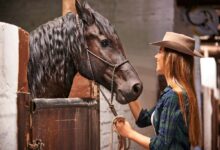by Ahmed Yousef,
Few rulers in European history combined the sword, the sceptre, and the scholar’s pen with the ease of Emperor Frederick II (1194–1250). King of Sicily, Holy Roman Emperor, and patron of arts and sciences, he was a monarch who thought like a philosopher and experimented like a naturalist. While his famous treatise De Arte Venandi cum Avibus (“On the Art of Hunting with Birds”) immortalised his fascination with falconry, the emperor’s interests extended far beyond the sky. His passion for the horse—its training, medicine, and symbolism—was equally profound and placed him at the centre of a remarkable cultural exchange between the Arabic world and medieval Europe.
In an age when most monarchs judged horses merely as tools of war or status, Frederick II regarded them as subjects of study, beauty, and science. His court in Sicily, where Latin, Greek, and Arabic cultures intertwined, became a laboratory of animal knowledge and horsemanship—one that owed a profound debt to the Arabic furūsiyya tradition, the medieval Islamic science of chivalry and equestrian mastery.
The Sicilian Crossroads
Frederick II grew up in a kingdom unlike any other in medieval Europe. The Norman kingdom of Sicily, which he inherited through his mother Constance, had long been a meeting point of civilisations. Arabs had ruled the island for more than two centuries before the Norman conquest, leaving behind libraries, architecture, and an administrative culture steeped in the Arabic language.
By the time of Frederick’s birth, Arabic remained the language of the court chancery, medicine, astronomy, and philosophy in Palermo. The young king was educated in this multicultural world—he spoke Arabic fluently, corresponded with Muslim rulers, and surrounded himself with scholars from across the Mediterranean. His tutors included Michael Scot, a Scottish scholar fluent in Arabic who translated the works of Averroes and Avicenna into Latin.
It was in this setting that Frederick encountered not only the intellectual achievements of Islam but also its equestrian sciences—a vast body of knowledge that combined veterinary medicine, horsemanship, and military technique under the term furūsiyya (from faras, meaning horse).
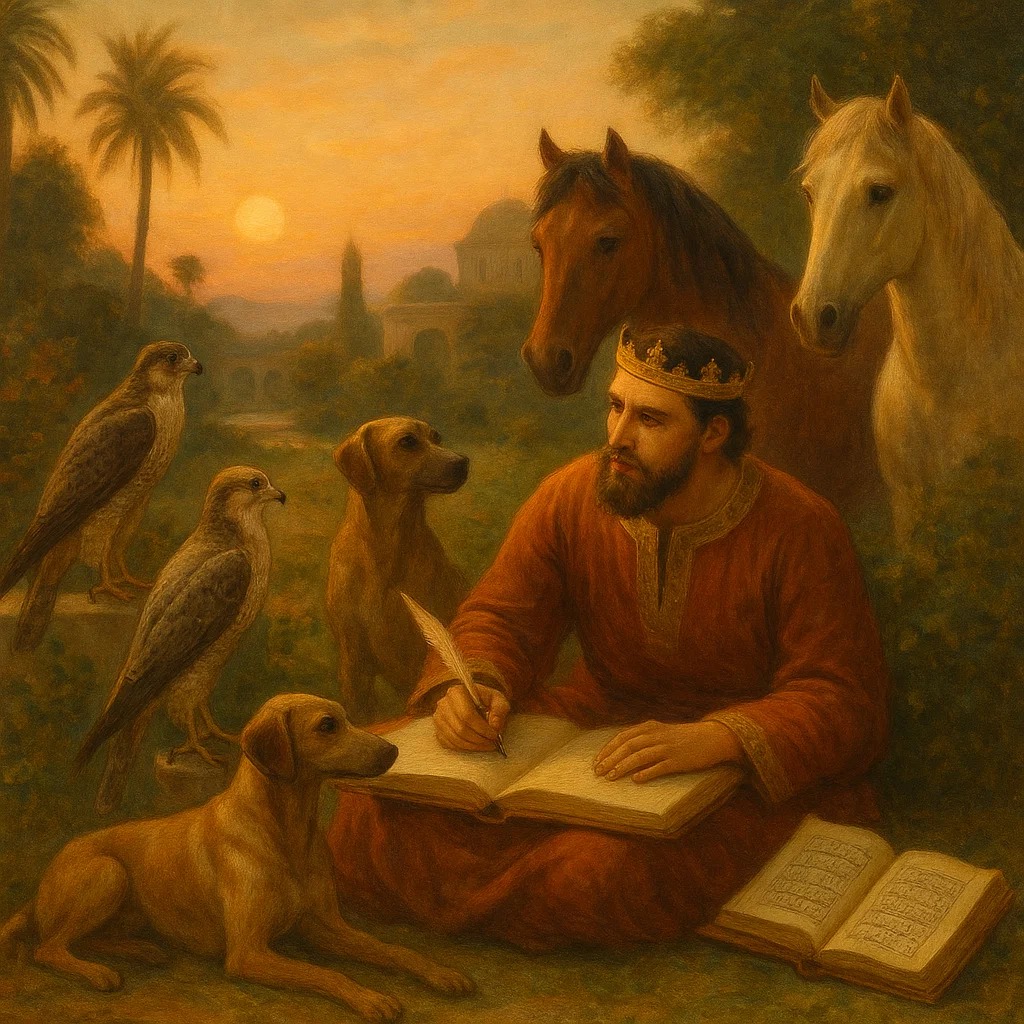
The Emperor and the Horse
Frederick’s fascination with the natural world is well documented. Chroniclers describe him as a man who “would rather converse with a philosopher than a prince.” He kept menageries of exotic animals and conducted early forms of zoological study. His scientific curiosity, however, also extended to the horse, which he viewed as both a living organism and a reflection of the divine order.
While there is no surviving equine treatise directly written by Frederick himself, his court produced one of the most important veterinary manuals of the Middle Ages: Giordano Ruffo’s De Medicina Equorum (“On the Medicine of Horses”)[1]. Ruffo, a nobleman from Calabria and a member of Frederick’s household, compiled the work around 1250. It became the cornerstone of medieval veterinary medicine, translated into numerous languages, and circulated throughout Europe for centuries.
What makes De Medicina Equorum particularly significant is its Arabic foundation. Ruffo drew on earlier Byzantine and Arabic texts on animal medicine—especially the works of scholars such as Abū Bakr ibn Badr and Ibn Akhī Hizam, whose treatises on the training and treatment of horses were known across the Mediterranean.[2] The structure of Ruffo’s book—dividing equine medicine into diseases of the head, limbs, and internal organs—mirrors Arabic veterinary organisation, and several of the remedies described are derived directly from Arabic sources.
Arabic Influence and the Furūsiyya Tradition
The furūsiyya literature of the Islamic world was far more than a set of manuals for riding and healing horses. It was a comprehensive philosophy of chivalry—combining physical skill, moral conduct, veterinary knowledge, and military discipline. Its practitioners, known as fursān, were not only knights but also scholars of anatomy, physics, and medicine.
Arabic furūsiyya manuals such as Ibn Akhī Hizam’s Kitāb al-Furūsiyya wa-l-Bayṭara and al-Aqraʿ’s Kitāb al-Furūsiyya (Book of Horsemanship) emphasised the ethical relationship between horse and rider: the duty of care, precise feeding, and the importance of calm and humane training. These principles contrast sharply with many early European attitudes toward animals, which tended to prioritise obedience over welfare.
Frederick’s exposure to this intellectual and moral framework—likely through Arabic-speaking scholars and translated texts—reshaped how horses were understood in Europe. His court valued observation, classification, and experimentation, traits central to Arabic science.
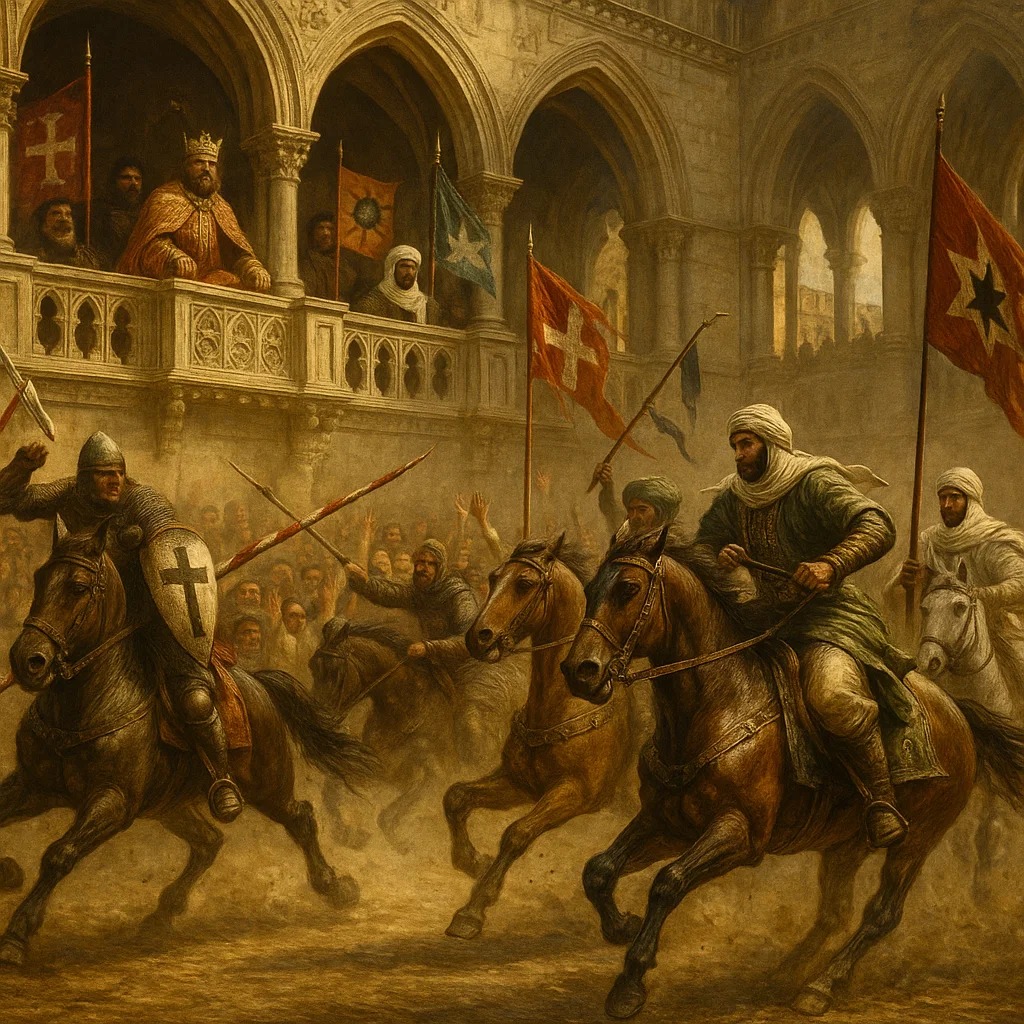
Giordano Ruffo and the Scientific Horse
Ruffo’s De Medicina Equorum is the clearest reflection of Frederick’s scientific ethos. Rather than relying on superstition or divine explanation, Ruffo analysed disease through observation, describing symptoms, causes, and treatments in methodical detail. He wrote, “The horse is the mirror of the rider’s soul; when it is ill, the rider too is diminished.”[3]
This rational, almost empirical approach mirrored Arabic veterinary practice. Arabic texts from as early as the ninth century treated animal illness as a medical science, complete with pharmacological recipes, surgical techniques, and preventive measures. The Arabic term bayṭara—meaning veterinary medicine—entered European usage via Sicily and Spain, influencing the later Latin hippiatria.
One striking example of knowledge transfer lies in Ruffo’s remedies. His use of camphor, myrrh, and aloes for equine wounds follows almost verbatim Arabic prescriptions from Kitāb al-Bayṭara. Likewise, his recognition of diet, temperament, and exercise reflects the holistic view found in Arabic sources, centuries before such ideas became mainstream in Europe.[4]
The Horse as a Symbol of Chivalry
Beyond medicine, the horse in Frederick’s world symbolised chivalry, discipline, and divine harmony—concepts with deep Arabic roots. The furūsiyya tradition treated riding not merely as a skill but as a moral art that demanded balance, courage, and humility. This philosophy resonated with Frederick’s efforts to reform the European concept of chivalry from mere warfare to intellectual and ethical refinement.
Frederick’s court hosted tournaments, equestrian displays, and breeding programmes that emphasised elegance, control, and precision—values parallel to Arabic riding schools in Damascus and Cairo. His knights learned not only to wield the lance but to care for their mounts, measure their gait, and understand their psychology. The emperor’s own approach to command—calm, calculated, and disciplined—reflected this same harmony between human and animal.
It is telling that his contemporary critics in Europe often accused him of being “too Eastern” or “too philosophical,” as though compassion and curiosity were foreign traits. Yet it was precisely this cross-cultural perspective that enabled Frederick to elevate the horse from a mere tool of battle to a partner in the pursuit of knowledge and grace.
From Falcons to Stallions: The Emperor as Naturalist
Frederick’s De Arte Venandi cum Avibus is often cited as the first modern work of zoology because of its rigorous observation of birds. But its method—classification through direct experience, rejection of myth, and careful experiment—applies equally to his understanding of horses. Chroniclers record that he bred Arab horses in his royal stables and exchanged correspondence with Muslim breeders regarding bloodlines and traits.[5]
His interest in animal psychology, anatomy, and breeding stemmed from a conviction that nature operated through discoverable laws, a belief shared with Arabic philosophers like Ibn Rushd (Averroes). While European theology of the time warned against probing nature too deeply, Frederick embraced it as a path to divine understanding. The horse, with its strength, intelligence, and loyalty, became for him a symbol of the natural order—governed by reason rather than superstition.
Legacy: The Arabic Foundations of European Horsemanship
The influence of Arabic horse culture did not end with Frederick’s death in 1250. His court’s synthesis of Arabic veterinary science and European chivalry laid the groundwork for later equestrian traditions in Italy, Spain, and France. The Medicina Equorum was translated into French as Le Livre des Chevaux, into German as Rossarzneibuch, and served as a model for Renaissance veterinary texts.
Meanwhile, the ideals of furūsiyya—discipline, harmony, and respect between horse and rider—echoed through the rise of European dressage and classical riding. The very notion of the “noble horse” and the “educated rider” owes something to this medieval dialogue between Palermo and Damascus.
In the centuries that followed, Europe would come to prize the Arabian horse for its intelligence, endurance, and elegance—qualities long celebrated in Arabic poetry and manuals. Frederick II’s Sicilian stables, enriched by Eastern breeding lines and veterinary practice, may well have been among the first laboratories for this cross-cultural fusion.
Thus, the story of Frederick II and the horse is not simply one of royal curiosity. It is a story of translation—not only between languages but between worlds. In his court, the wisdom of Arabic veterinarians, the discipline of knights, and the curiosity of scholars met in a rare harmony. The result was a new European understanding of the horse as a creature worthy of study, compassion, and respect—a legacy that continues in every modern stable and riding school that values science as much as tradition.
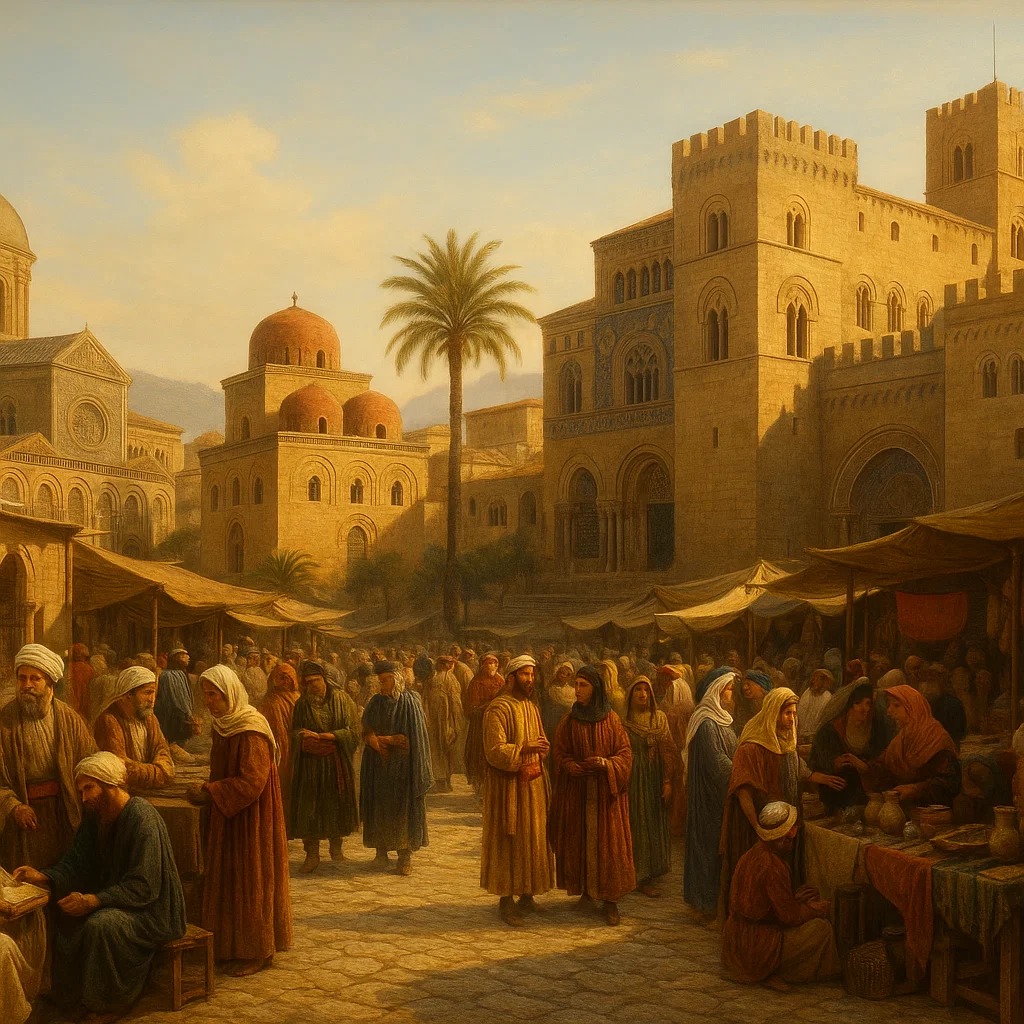
References
- Giordano Ruffo, De Medicina Equorum, c. 1250. Critical edition by A. Pérez-Álvaro, Universidad de León, 1998.
- Ibn Akhī Hizam, Kitāb al-Furūsiyya wa-l-Bayṭara, 9th century; translated excerpts in C.A. Perry, Islamic Veterinary Medicine in the Middle Ages, Cambridge, 2012.
- E. Kantorowicz, Frederick the Second, Frederick Ungar Publishing, New York, 1957.
- R. O’Rourke, “Arabic Veterinary Influence in Medieval Latin Europe,” Journal of Medieval History, Vol. 35, 2009.
- M. Scott (trans.), Correspondence between Frederick II and Al-Kāmil, in Sources for the Sixth Crusade, Oxford Medieval Series, 1995.
- M. Pérez-Álvaro, “Equine Science in the Court of Frederick II,” Revista de Historia Medieval, Vol. 12, 2019.
- D. Alexander, Furusiyya: The Art of Chivalry in the Islamic World, The Metropolitan Museum of Art, 2019

